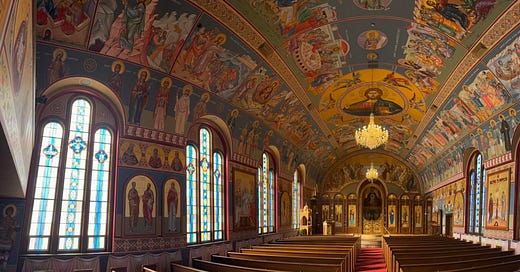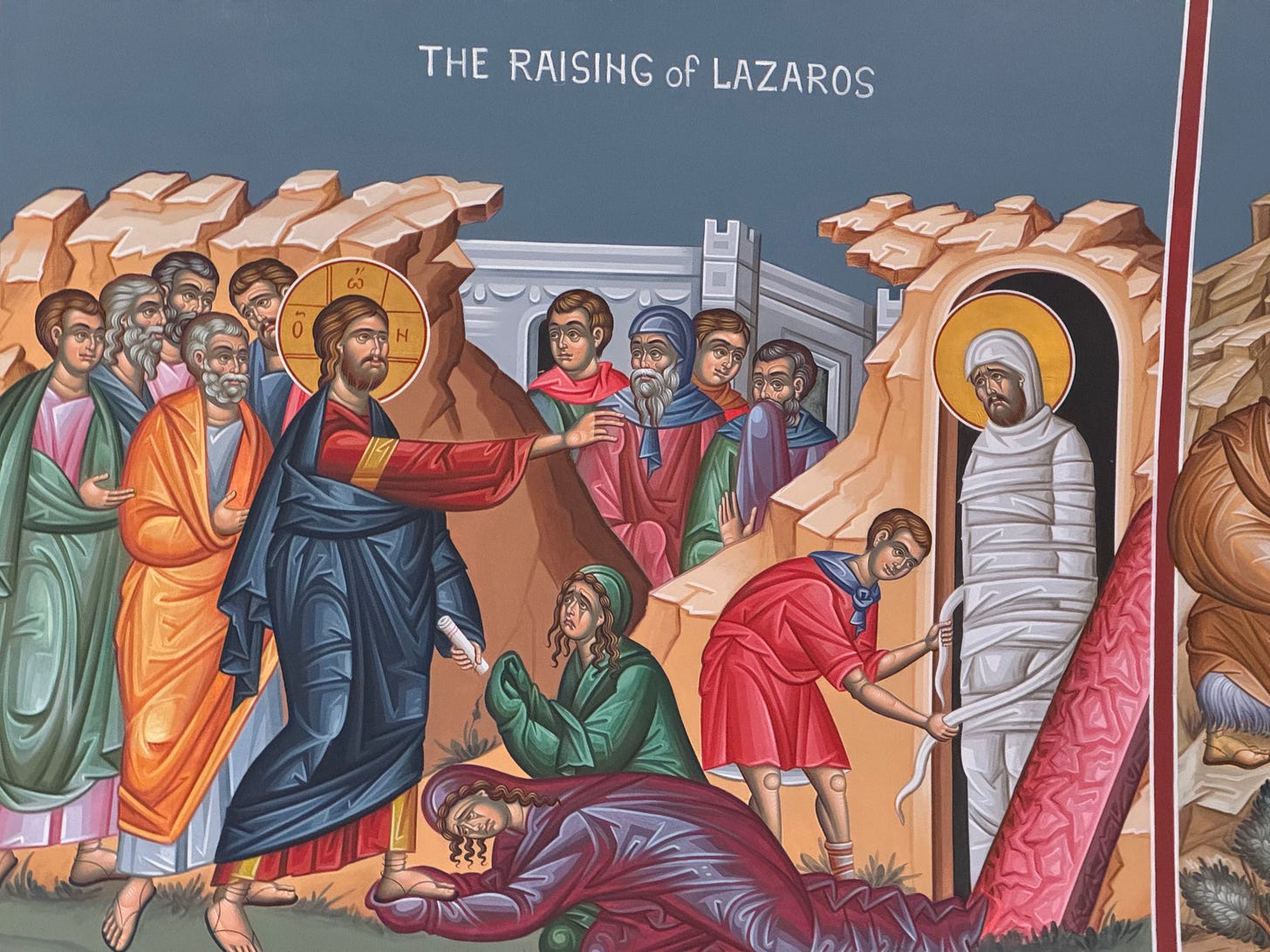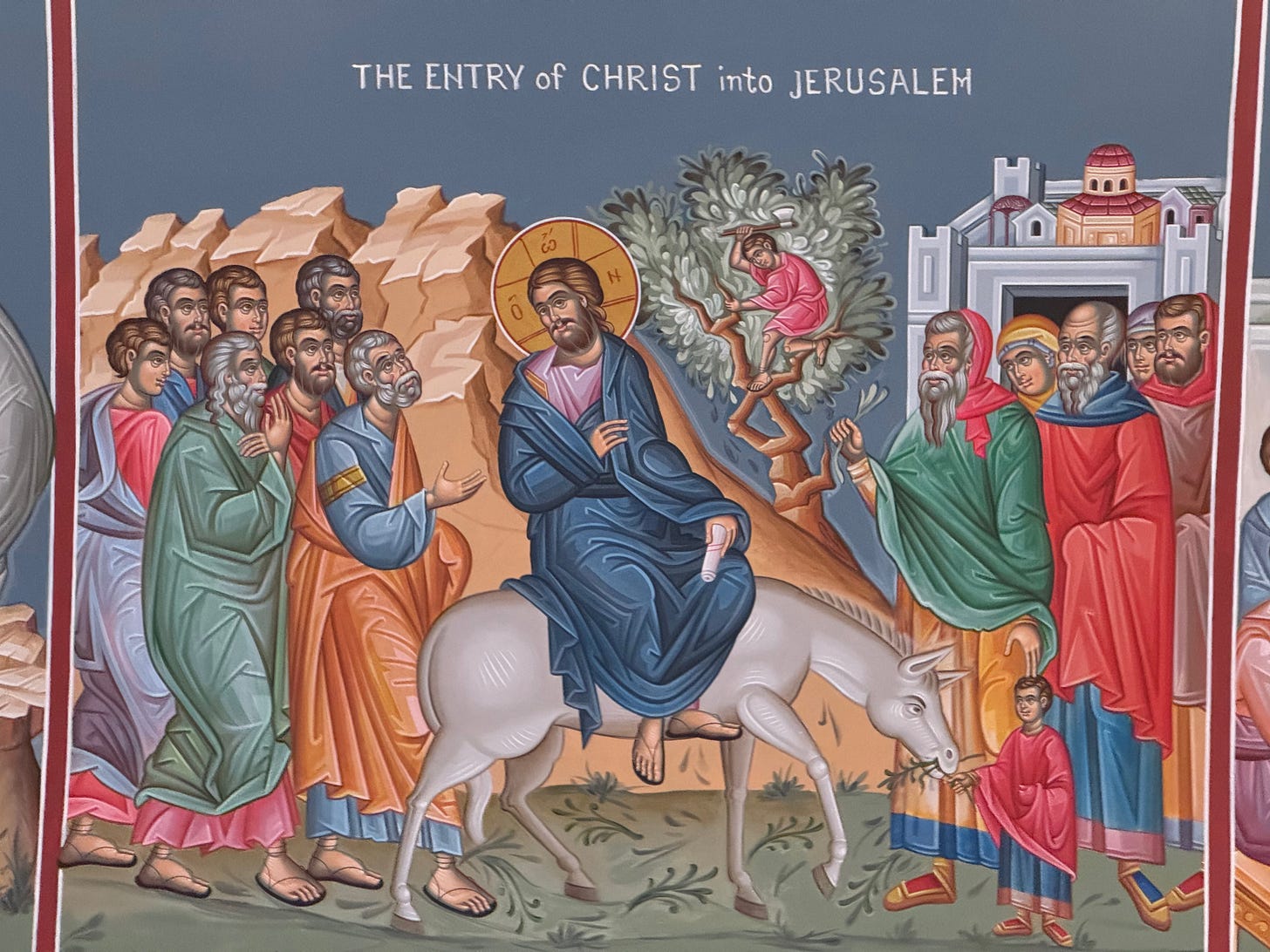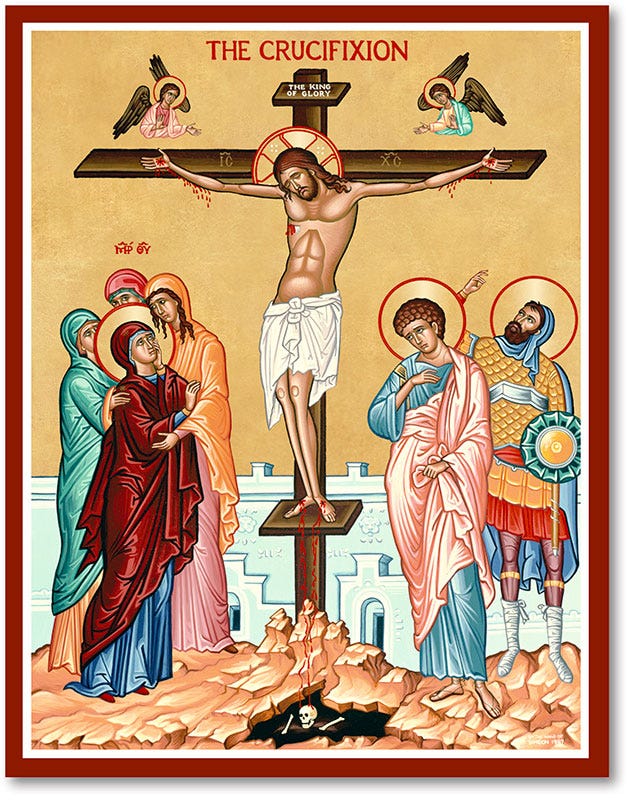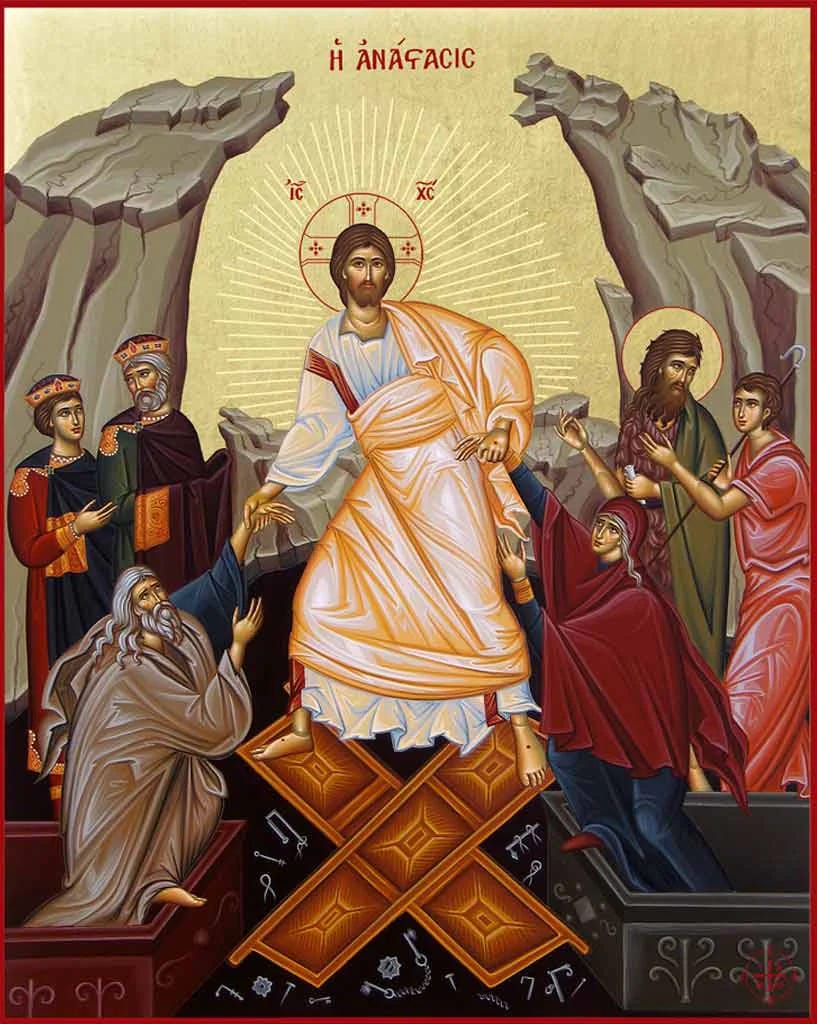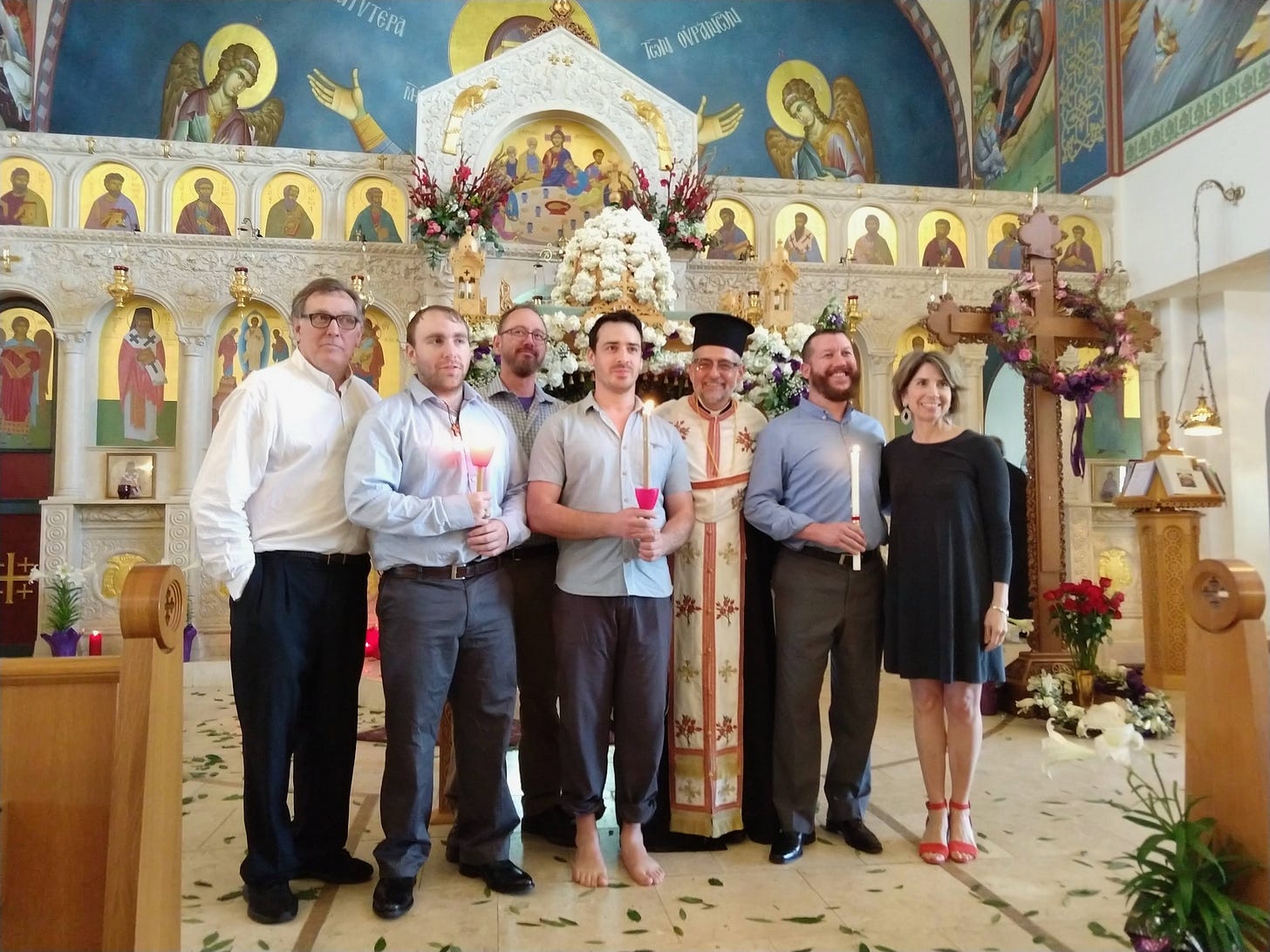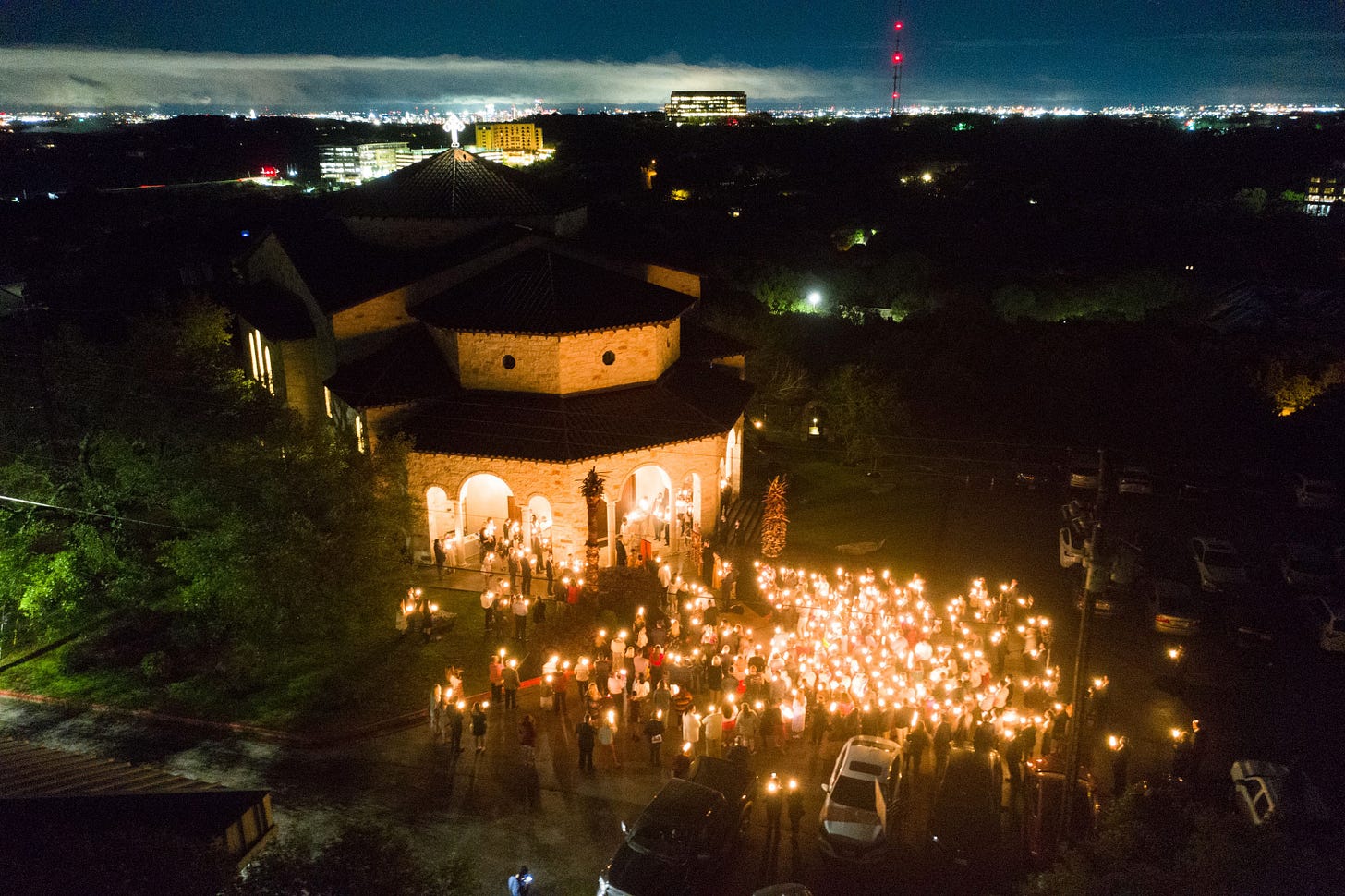A Newb's Guide to Orthodox Holy Week
The Orthodox world has an influx of inquirers and converts lately, and my lovely parish is no exception. So I decided to share some practical thoughts on how to navigate Holy Week. I primarily intend this for my friends, but maybe some others will find it useful too. Some of this is wisdom passed on from my godfather, and some is my opinions gleaned from six short years in the Church.
The six weeks of Lent lead up to Holy Week, which is the final and most intense perparation period for Pascha itself. Pascha is Greek for “Passover”, and it is the celebration of the resurrection of Christ, his triumph over death, and the salvation of the Christian people. It is the feast of feasts, the festival of all festivals. Pascha begins a joyous 40 day period in church where we will sing the triumphant Paschal hymn - “Christ is risen from the dead, trampling down death by death, and to those in the tomb, granting life”. There is no sweeter sound to an Orthodox Christian.
In Holy Week, we walk with Jesus in his last days leading up to his passion, sacrificial death, and resurrection. There are services every day meditating on the meaning of each step along the path.
There is a sense in Orthodox liturgics of making present events with eternal significance. As modern day parishioners, we enter into the events depicted. Thus, the hymns of the church use the present tense - on Palm Sunday we chant “Today Christ is entering the Holy City, seated on a foal”, and on Holy Thursday we sing “Today, he is hung upon the tree, who hung the earth upon the waters”. There is the real sense that we are present with Christ every step of the way.
It is best to make all the services, or as many as you can. Start with Lazarus Saturday and the baptisms that usually follow afterwards, continuing through Pascha and ending with Agape Vespers on Sunday afternoon. Enjoy whatever picnics, parties, or other festivities your parish provides. And continue to come to church throughout the Passover season, singing the triumphant hymn of Christ’s resurrection.
But if you can’t make every service, my personal “can’t miss” list is: a Bridegroom matins, Holy Thursday evening, and the Paschal service itself (both Orthros and Liturgy). This minimalist set of services does much to reveal the deeper realities in the story of Jesus’ death and resurrection, and it will feed your heart so that you will want to make more services next year.
With the preliminaries out of the way, let’s walk through the services one by one.
Lazarus Saturday
The cycle of services begins with liturgy on Lazarus Saturday. Not part of Holy Week proper, Lazarus Saturday is a preview or foretaste of Pascha. On Saturday Jesus raises his friend Lazarus from the dead, demonstrating his power over death. This is his last miracle before heading up to Jerusalem for Passover. It is one of the most well-attended Saturday liturgies of the year, and it is a customary date for converts to be received into the Church by Baptism or Chrismation. In most parishes, this will happen after the liturgy.
The life of Lazarus is a beloved story for Christians everywhere. It is an infusion of hope to get us through the darkness of the passion. In many parishes, the choir will offer the haunting theologically rich hymn “Rejoice oh Bethany”
Palm Sunday
The first day of Holy Week is Palm Sunday. On Sunday, Jesus enters into Jerusalem for the last time, cheered on by a great multitude laying palm branches on his path, riding on the foal of an donkey as foretold by the prophets. The Church is decorated with palm leaves and people hold them to make present story of the Gospel.
The gospel reading for the day is the source for half of the thrice-holy hymn that we sing every liturgy at the beginning of the anaphora - “Hosanna in the highest! Blessed is he that comes in the Lord’s name”. Here, the people of the Jerusalem suburbs are themselves quoting the Psalmist. Holy Week is full of morsels like this, we encounter the original events that form the foundation of our weekly worship throughout the rest of the year.
This is one of the most crowded services of the year, sometimes exceeding even Pascha. In my parish, the young children perform a short choral concert after the service while holding palms.
Palm Sunday is a joyous feast. There is a brief break in the Lenten fast, as fish is permitted on this day. But to those who are familiar with the gospel story, there is a bitter, ironic underside to the joyous tone of the day. The people of Jerusalem rejoice and cheer on the arrival Christ, while being unaware of the tragedy that is about to happen.
Bridegroom Matins (Sunday, Monday, and Tuesday, and Wednesday night)

Matins is normally a morning prayer service, featuring psalms, gospel readings, petitions, and hymns. But during Holy Week, it is said in place of Vespers in the evening. The Bridegroom matins focus on the figure of Christ as the Bridegroom of the church, with the cross as the marriage bed. The hymns urge us to keep watchful for his imminent arrival (Matthew 25:1-23). It is a deep mystery being celebrated: the consummation of the union between Heaven and Earth. It is the ultimate expression of Christ’s love, as he lays down his life for his friends.
Tuesday evening includes the hymn of St. Kassiani, probably the best known female melodist of the church. Recently, she seems to be a popular patron saint for young girls baptized into the church.
Holy Unction (Holy Wednesday)
Unction is a service of anointing with oil for the healing of soul and body. As the Apostle James says, “Is anyone among you sick? Let him call for the elders of the church, and let them pray over him, anointing him with oil in the name of the Lord. And the prayer of faith will save the sick, and the Lord will raise him up.” The service is on the long side, involving seven gospel readings and seven prayers to consecrate the holy oil.
Unction is a sacrament reserved for currently baptized Orthodox Christians. The pattern this creates in the rhythm of the week is the common pattern of purification or healing before approaching the holy things. Following this pattern, the priests of the Old Testament cleansed themselves before offering sacrifice, and our Christian priests wash their hands before celebrating a liturgy. Similarly for the laity, we go to confession before approaching the Eucharist, or fast before great festivals of the church.
The Institution of the Eucharist (Holy Thursday Morning)
Now we are getting into the thick of it. On Holy Thursday morning, in the upper room, the Lord eats his last meal with his disciples, and he gives them wine and bread to eat which he blesses to mystically become his body and blood. This is the central rite of all Christianity. As this is the origin of the worship we follow for the rest of the year, I love to make it to this service. A little extra sacrament is consecrated that is kept on the altar and used in case of emergencies for the remainder of the year.
The Gospel readings cover Christ washing his disciples’ feet, the last supper, his prayer at Gethsemane, his betrayal by Judas, and finally his betrayal by Peter.
The Passion of the Lord (Holy Thursday Evening)
On Holy Thursday evening, Christ is betrayed by Judas and given up to be tried by the Jewish authorities and executed by the Romans. The church is kept dark, and a candle is lit for each gospel as it is read.
This is the darkest service of the year, and the longest. But it is an essential contrast that elevates the joy of Pascha. It drives home the painful reality of the Lord’s betrayal and sacrifice.
About halfway through, the icon of Jesus on the Cross, normally kept behind the altar, is processed around the church and to the middle of the solea. This is accompanied by hymnody about the great mystery we are witnessing, that the author of creation should suffer a brutal and humiliating death.
At the end of the service, each person has the opportunity to venerate the cross and depart in silence.
In some parishes, a funeral vigil is kept, and people take turns reciting the psalms over the cross all night.
Some keep the custom to cease eating all food from this point until after the resurrection of Christ on Pascha.
Good Friday/Holy Friday
On Good Friday, Christ is laid in the tomb, and the disciples lament not knowing what is about to happen.
The morning begins with the prayers of the Royal Hours. In the Afternoon, Christ is removed from the icon of the cross and a decorated tomb is placed in front of it. In the evening, the hymns of lamentation are offered, often sung by the whole congregation. Depending on local custom, the tomb is often processed around the church grounds as part of a candle lit funeral procession.
The First Resurrection (Holy Saturday Morning)
A liturgy is offered on Holy Saturday morning. On Holy Saturday, Jesus descends into Hades and frees the righteous souls imprisoned there. In the West, this is often referred to as “The Harrowing of Hell”.
It’s a joyous service. In the Greek custom, the clergy throws Bay leaves into the congregation as if in a victory parade while the laity beats on the pews or shakes keys to represent the despoiling of Hades and the breaking of its gates. The signature hymn of the day is “Arise Oh God”, taken from Psalm 82.
This event is commemorated in the icon of the resurrection. It shows Christ breaking the doors of Hades and grabbing Adam and Eve by the wrist and pulling them out. This represents the salvation of the human race, since Adam and Eve are the parents of us all and also the first to fall into sin and death. Also depicted are other Old Testament figures and John the Baptist, who have been awaiting the arrival of the Messiah.
Less commonly, people are baptized on Holy Saturday after liturgy. I was!
Pascha (Holy Saturday Night/ Holy Sunday Morning)
Pascha begins in the evening on Saturday with the Paschal Matins. Sometime after midnight, the Paschal liturgy will start and continue into the small hours of Sunday morning.
Pascha! What is there to say about Pascha? It is the feast of feasts, the holy day of holy days. It features some of the most lovely prayers, hymns, and traditions of the liturgical year.
After a long Lent of fasting and repentance, and the sorrow of Holy Week, how sweet it is the first time to sing “Christ is Risen from the dead, trampling down death by death”! How sweet it is to greet each other with “Christ is risen!” “Truly he is risen!”.
It begins with a darkened church. The priest comes out through the royal doors with a lit candle chanting “Come receive the light”. The flame is passed around to the congregation, representing the light of Christ entering into the world. It is reminiscent of Pentecost, when the Holy Spirit came as tongues of flame upon Jesus’s disciples.
The Paschal canon, sung during the Matins, is a favorite of mine. As I was married during the Paschal season, we used it as the entrance hymn at my wedding and it will forever be in my heart. The rousing homily of St. John Chrysostom concludes Matins and takes us into the liturgy.
Death, where is your sting? Hades, where is your victory? Christ is risen and you are overthrown. Christ is risen and demons have fallen. Christ is risen and angels rejoice. Christ is risen and life rules. Christ is risen and not one dead remains in the tomb. For Christ, having risen from the dead, has become the firstfruits of those that slept. To Him be the glory and the dominion forever. Amen
The Gospel reading is the prologue of John. The poetic words of the Evangelist, so long awaited, are thrilling, illuminating the meaning of the earlier candle ritual.
In the beginning was the Word, and the Word was with God, and the Word was God. He was in the beginning with God. All things were made through Him, and without Him nothing was made that was made. In Him was life, and the life was the light of men. And the light shines in the darkness, and the darkness did not comprehend it.
Concluding the liturgy, the long Lenten fast is broken, and the people feast and celebrate. Eventually, people filter out and try to get a few hours of rest
Agape Vespers (Bright Sunday Afternoon)
Agape Vespers gives us a chance to greet each other once again with the Paschal greeting, and test out our tired voices on the Paschal hymn. The Gospel reading commemorates Christ appearing to his disciples after his resurrection. The tradition is to read it in as many different languages as the parish can manage to show the universality of the Gospel message.
Often, parishes will host some kind of picnic or potluck afterwards. Meat and cheese are back on the menu, boys and girls!
Parting Words
There’s nothing quite like Pascha! It is the point in which the whole year pivots around, well, all of time to be exact! It is the event that leaves the angels in awe. It is the accomplishment of the mystery of our salvation and the most sacred rite of our faith. May we all drink as deeply as we are able, year after year.
Christ is Risen!
